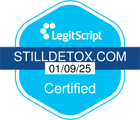What Is Targin? A Dual-Action Pain Medication
Targin is a brand-name, prolonged-release tablet that pairs oxycodone, a potent opioid analgesic, with naloxone, an opioid antagonist. Oxycodone targets the central nervous system to dull severe pain, making it a go-to for conditions requiring round-the-clock relief—like cancer or chronic non-cancer pain—when non-opioid options fail. Naloxone, meanwhile, counters opioid-induced constipation by blocking oxycodone’s effects on gut receptors, though it’s poorly absorbed into the bloodstream when taken orally. Approved in Germany in 2006 and the U.S. in 2014, Targin balances pain control with a common opioid drawback, per NIDA 1.
Available in strengths like 5 mg/2.5 mg to 40 mg/20 mg (oxycodone/naloxone), it’s dosed every 12 hours, with a daily cap of 80 mg oxycodone and 40 mg naloxone. It’s not for short-term or mild pain—its design suits chronic cases needing consistent management, a focus we address in treatment.
How Targin Works? Oxycodone/Naloxone
Oxycodone in Targin binds to opioid receptors in the brain and spinal cord, blocking pain signals—a mechanism driving its narcotic strength. Naloxone, however, stays mostly in the gut when swallowed, counteracting oxycodone’s tendency to slow digestion and cause constipation. This dual action aims to maintain analgesia while improving bowel function, a benefit backed by a 2008 study showing reduced constipation versus oxycodone alone 2. The prolonged-release formula ensures steady relief over 12 hours.
What is Targin’s edge? Unlike standalone oxycodone, it proactively addresses a side effect plaguing up to 40% of opioid users, per NIH data. Targin’s design seeks to keep treatment tolerable, though its opioid core still carries dependence risks we monitor closely.
Who Uses Targin? Target Patients and Prescribing
Targin is prescribed for adults with severe, chronic pain—cancer-related or otherwise—unresponsive to non-narcotic analgesics. It’s not for kids or casual pain; the FDA and TGA limit it to cases needing daily, long-term opioid therapy. Starting doses are low (e.g., 5 mg/2.5 mg twice daily), titrated up as needed, with oversight to avoid over-reliance.
Targin has a failsafe abuse ingredient; Naloxone. It gets activated if crushed which aims to curb non-oral abuse including snorting or shooting.
Though oral overuse still remains a risk.
Risks of Targin Use: Addiction and Overdose
Targin’s oxycodone component can lead to physical dependence, even in prescribed use—SAMHSA pegs opioid misuse and abuse at over 10 million Americans in 2020 3. Withdrawal symptoms like nausea, sweating, and agitation hit if stopped abruptly, requiring gradual tapering. Overdose is another threat—crushing tablets bypasses naloxone’s gut focus, risking respiratory depression. The CDC notes over 107,000 drug deaths in 2021, many opioid-related 4. Other side effects include drowsiness, nausea, and rare naloxone-driven withdrawal if misused.
What is Targin’s downside? It’s not immune to addiction’s grip.
At Still Detox, we see patients whose pain relief turned into reliance—or worse, recreational abuse despite naloxone’s presence.
Managing Targin at Still Detox: Support and Recovery
At Still Detox in Boca Raton, we guide patients through Targin’s complexities—whether tapering off or recovering from misuse. Medically supervised detox eases withdrawal with gradual dose cuts, supported by medications for symptoms like anxiety or nausea. Therapy—Cognitive Behavioral Therapy and group sessions—rebuilds coping skills, while holistic care (nutrition, exercise) restores health. Research shows brain recovery within months sober, with dopamine stabilizing in 90 days 5.
What is Targin to someone healing? A past chapter, not a life sentence. Our tailored plans in Boca Raton address pain, dependence, or both, ensuring our patients move forward. If Targin’s benefits have shifted to burdens, call (561) 556-2677—Still Detox offers evidence-based care to reclaim control.









